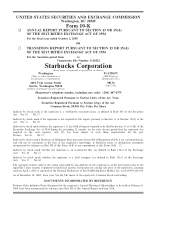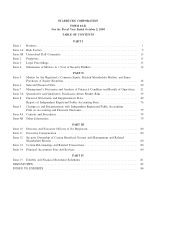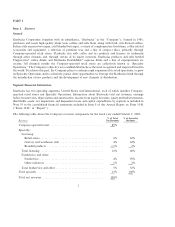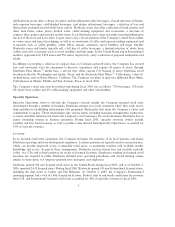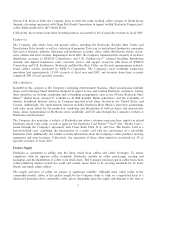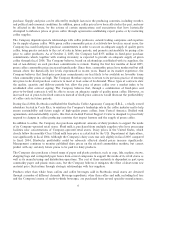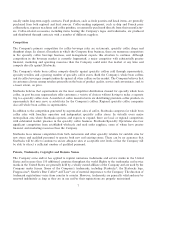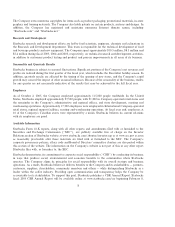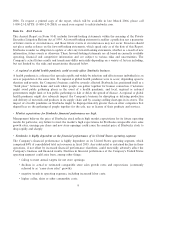Starbucks 2005 Annual Report Download - page 11
Download and view the complete annual report
Please find page 11 of the 2005 Starbucks annual report below. You can navigate through the pages in the report by either clicking on the pages listed below, or by using the keyword search tool below to find specific information within the annual report.2006. To request a printed copy of the report, which will be available in late March 2006, please call
1-800-23-LATTE (1-800-235-2883) or email your request to [email protected].
Item 1A. Risk Factors
This Annual Report on Form 10-K includes forward-looking statements within the meaning of the Private
Securities Litigation Reform Act of 1995. A forward-looking statement is neither a prediction nor a guarantee
of future events or circumstances, and those future events or circumstances may not occur. Investors should
not place undue reliance on the forward-looking statements, which speak only as of the date of this Report.
Starbucks is under no obligation to update or alter any forward-looking statements, whether as a result of new
information, future events or otherwise. These forward-looking statements are all based on currently available
operating, financial and competitive information and are subject to various risks and uncertainties. The
Company's actual future results and trends may differ materially depending on a variety of factors including,
but not limited to, the risks and uncertainties discussed below.
‚A regional or global health pandemic could severely affect Starbucks business.
A health pandemic is a disease that spreads rapidly and widely by infection and affects many individuals in an
area or population at the same time. If a regional or global health pandemic were to occur, depending upon its
duration and severity, the Company's business could be severely affected. Starbucks has positioned itself as a
""third place'' between home and work where people can gather together for human connection. Customers
might avoid public gathering places in the event of a health pandemic, and local, regional or national
governments might limit or ban public gatherings to halt or delay the spread of disease. A regional or global
health pandemic might also adversely impact the Company's business by disrupting or delaying production
and delivery of materials and products in its supply chain and by causing staffing shortages in its stores. The
impact of a health pandemic on Starbucks might be disproportionately greater than on other companies that
depend less on the gathering of people together for the sale, use or license of their products and services.
‚Market expectations for Starbucks financial performance are high.
Management believes the price of Starbucks stock reflects high market expectations for its future operating
results. In particular, any failure to meet the market's high expectations for Starbucks comparable store sales
growth rates, earnings per share and new store openings could cause the market price of Starbucks stock to
drop rapidly and sharply.
‚Starbucks is highly dependent on the financial performance of its United States operating segment.
The Company's financial performance is highly dependent on its United States operating segment, which
comprised 84% of consolidated total net revenues in fiscal 2005. Any substantial or sustained decline in these
operations, if not offset by increased financial performance elsewhere, could materially adversely affect the
Company's business and financial results. Declines in financial performance of the Company's United States
operating segment could arise from, among other things:
‚ failing to meet annual targets for net store openings;
‚ declines in actual or estimated comparable store sales growth rates and expectations (commonly
referred to as ""same store sales'' growth);
‚ negative trends in operating expenses, including increased labor costs;
‚ higher coffee, dairy or other commodity costs;
9

